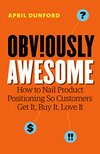Obviously Awesome: How to Nail Product Positioning so Customers Get It, Buy It, Love It
amazon.com
Saved by Rishi and
Obviously Awesome: How to Nail Product Positioning so Customers Get It, Buy It, Love It

Saved by Rishi and
When to use the Create a New Game style Because this style of positioning is so difficult, it should only be used when you have evaluated every possible existing market category and concluded that you cannot position your offering there, because doing so would fail to put the focus on your true differentiators and value.
Think of your product’s strengths, your market context and a trend that is relevant to your customer base as three overlapping circles. You are aiming for the center, where all three intersect.
STEP 10. Capture Your Positioning so It Can Be Shared
“If you change the way you look at things, the things you look at change.” WAYNE DYER Describing a trend without declaring a market can make your product cool but baffling.
The goal of the Big Fish, Small Pond style of positioning is to carve off a piece of the market where the rules are a little bit different—just enough to give your product an edge over the category leader. Like the Head to Head style of positioning, here you are leveraging what buyers already know about the broader market category, but you are call
... See moreTable 2. Positioning canvas Product name and one-line description Market category (and subcategory) The macro market and submarket (if applicable) that you compete in Competitive alternatives What would customers use if your product did not exist? Unique attributes What features/capabilities does your product have that the alternatives do not? Valu
... See moreSTEP 9. Layer On a Trend (but Be Careful)
Use abductive reasoning. The adage “if it looks like a duck, swims like a duck and quacks like a duck, then it probably is a duck” also applies to new products. With abductive reasoning, you choose a market category by isolating your key features and their value, and asking yourself, What types of products typically have those features? What catego
... See moreUnderstanding the customer’s problem wasn’t enough—to really understand how they perceived our strengths and weaknesses, we needed to understand the alternatives to which they compared us. Customers always group solutions in categories, but talking to them about problems doesn’t necessarily reveal those categories.